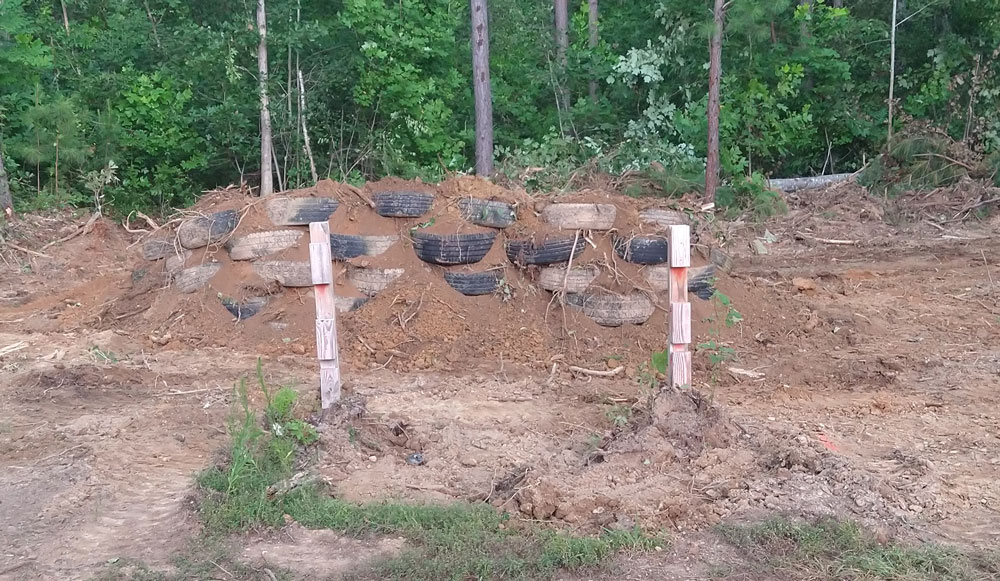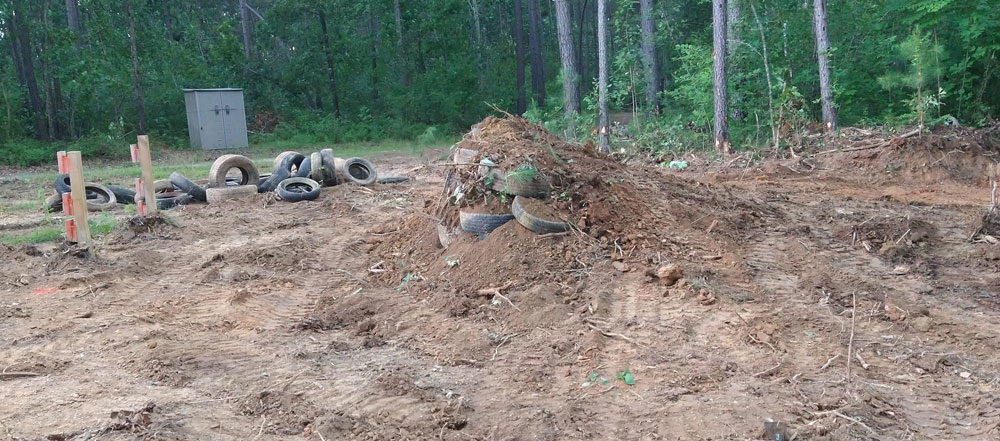-
If you are posting pictures, and they aren't posting in the correct orientation, please flush your browser cache and try again.
Edge
Safari/iOS
Chrome
You are using an out of date browser. It may not display this or other websites correctly.
You should upgrade or use an alternative browser.
You should upgrade or use an alternative browser.
Rifle Range Upgrade
- Thread starter yoderjac
- Start date
Jerry-B-WI
5 year old buck +
Is your shooting bench on a raised berm so that you're shooting a downward angle at the backstop?
yoderjac
5 year old buck +
Is your shooting bench on a raised berm so that you're shooting a downward angle at the backstop?
It is not on a berm, but with the lay of the land, it is a very slight downward angle. The berm is currently about 4'. Before I tore down the backstop it was only about 5'. I was concerned about safety. That is why I'm redoing it (now that I have the 35G). I'm hoping to get it to 7'-8' .
I was hoping to finish the basic structure tomorrow, but with the downpour we got this evening, I'll need to wait till things dry out before continuing. Hopefully by tomorrow afternoon.
Thanks,
Jack
yoderjac
5 year old buck +
Went back today but the disturbed soil was way too wet to work on the berm. Instead, I just did a little more clearing behind it so I've got a bigger area to scavenge soil from. I also did some cleanup around the shooting table and along the road where volunteer pines and other stuff was starting to block the view from the shooting bench to target. I spent the rest of the day doing chainsaw and other work. It was in the mid 90s today, so I was done working by 1400. I'm hoping it will be dry enough to work on it tomorrow morning.
yoderjac
5 year old buck +
By Saturday things were dry enough to work on it again. I got all the tires stacked and filled. I am having trouble getting dirt on the front. I made a mistake and only offset each row of tires by a few inches back so the front is so vertical, it won't hold dirt. I think over time, as the berm settles and stuff starts to grow, I'll be able to add more dirt in front and have it hold, at least as high as the target holder where most of the bullet impact will be. For now, I still have the potential ricochet risk with the tires, but The height and width of the berm are much better than the old dirt filled tires on cedar posts.
I was so hot and tired after a day in that heat that I didn't take a picture. I'll try to take one next week.
Thanks,
Jack
I was so hot and tired after a day in that heat that I didn't take a picture. I'll try to take one next week.
Thanks,
Jack
Wild Thing
5 year old buck +
That should get it done Jack. It does look like a lot of work though.
When I had a dozer in doing some other work, I just had him push up a berm for a backstop for my ranges (100 and 200).
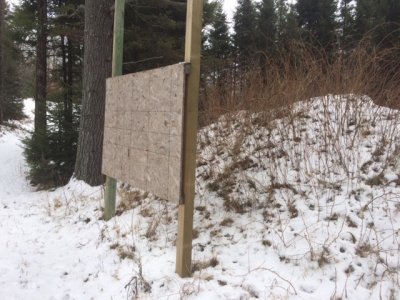
Sunk 2 4X4's and tacked 2 2X4's across them and then tacked up a sheet of 1/2" OSB - Done.
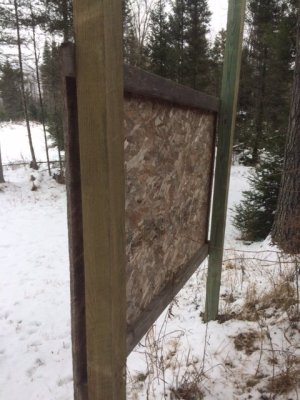
The bench is up on a ridge so we are shooting downhill anyway but the earth berm is a good safety net.
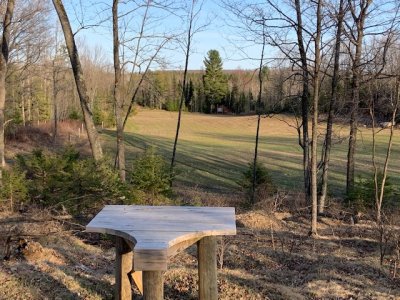
Same thing on the 100 yard range - earth berm pushed up with a dozer and a little smaller target butt.

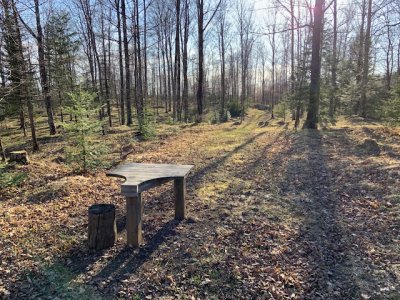 `
`
When I had a dozer in doing some other work, I just had him push up a berm for a backstop for my ranges (100 and 200).

Sunk 2 4X4's and tacked 2 2X4's across them and then tacked up a sheet of 1/2" OSB - Done.

The bench is up on a ridge so we are shooting downhill anyway but the earth berm is a good safety net.

Same thing on the 100 yard range - earth berm pushed up with a dozer and a little smaller target butt.

 `
`MRBB
5 year old buck +
just going to say, for safety reasons, its worth adding sides to your back stop, that extend out past in front of your target holder, like U shaped
back stop if you follow, it will add a layer of safety to things for you and those about your area! remember a center fire caliber bullet can travels a few miles, and a ricochet can go pretty far as well!
and I KNOW this is on private property, but if it was me, I would also, get behind it a some and put up posted signs saying shooting range danger
never know when some idiot trespasses they days!
back stop if you follow, it will add a layer of safety to things for you and those about your area! remember a center fire caliber bullet can travels a few miles, and a ricochet can go pretty far as well!
and I KNOW this is on private property, but if it was me, I would also, get behind it a some and put up posted signs saying shooting range danger
never know when some idiot trespasses they days!
I actually did the opposite of what you did. I used dirt filled tires for the BACK of my berm, to increase the steepness of the back side and reduce the amount of dirt required. The front side is gravity slope. My berm gets A LOT of shooting, and over time a trench will be shot through the berm. So I like having the thicker side on front so I don't have to fix it as often.Got back down today. It was too wet to work on it, but here is a pic of where I left things:

Thanks,
Jack
I have a different site where I built what was intended as a pistol-only berm where it was exclusively dirt filled tires, two rows offset, stacked over metal poles. Totally vertical. The berm is 20 yards from the firing position. I can't speak for .22 or 380, but 9mm and above there is non bounce-back, they penetrate the tires.
yoderjac
5 year old buck +
I actually did the opposite of what you did. I used dirt filled tires for the BACK of my berm, to increase the steepness of the back side and reduce the amount of dirt required. The front side is gravity slope. My berm gets A LOT of shooting, and over time a trench will be shot through the berm. So I like having the thicker side on front so I don't have to fix it as often.
I have a different site where I built what was intended as a pistol-only berm where it was exclusively dirt filled tires, two rows offset, stacked over metal poles. Totally vertical. The berm is 20 yards from the firing position. I can't speak for .22 or 380, but 9mm and above there is non bounce-back, they penetrate the tires.
Interesting. I had not thought of that option. I just seeded mine last week. Hopefully as vegetation takes root, I'll be able to cover more tires in front. I can't say that I'm real worried about ricochet. I think most of that is slow high caliber rounds at closer ranges. This ranges gets little use. It is basically a sight-in range that probably gets less than a dozen days of use per year.
Lots of good ideas and some good safety tips as well. I “was” planning on building a berm/mound style backstop, using the excavated dirt from two projects I did over summer. But after reading through this thread, I see the value in creating some type of structure to hold the dirt in place as opposed to just a mound. Does anyone recommend a depth for how much dirt there should be from front to back of the mound? This will be a 100 yd range with mostly .308 type caliber hunting rounds and .22LR being shot into it. But I’d like to overbuild it for safety and future larger caliber use. Thanks.
You can do just a dirt mound, it will just take more dirt and space. By using stacked filled tires on the back of mine I made that side steeper and required less dirt....left the front natural slope.
How deep the berm needs to be is more a maintenance question than a safety question; it does not take a large depth of dirt to stop bullets. The top of my 100yd berm is about 6ft because I had the dirt and didn't want to have to fix it much. It's been about 5 years since I last touched it and the trench through the top is 2+ feet deep from the impacts throwing the dirt out. Next year I'll probably replenish. My 300yd berm is only about 3ft across the top and it's about shot through, I will be putting some work to do the tire fix on it so I can get to about 5ft across the top in the same footprint.
How deep the berm needs to be is more a maintenance question than a safety question; it does not take a large depth of dirt to stop bullets. The top of my 100yd berm is about 6ft because I had the dirt and didn't want to have to fix it much. It's been about 5 years since I last touched it and the trench through the top is 2+ feet deep from the impacts throwing the dirt out. Next year I'll probably replenish. My 300yd berm is only about 3ft across the top and it's about shot through, I will be putting some work to do the tire fix on it so I can get to about 5ft across the top in the same footprint.
Foggy47
5 year old buck +
Ive got a big pile of logs with earth fill as a back stop. We dont do much shooting at my range.....just an occasional shoot each year and a few sight ins. Nothing behind my targets or berms for about 1 mile or more....just lots of trees and vegetation. I've always been under the impression that if the bullet lands in relatively soft dirt....then any ricochets are not going too far. Angle hits on hard rock or steel could be another matter. I never hear of issues others have (around our low population area)......but you can never be too safe.
Sometimes I think I should have a somewhat higher mound where we shoot to improve the downward angle a bit. Can always improve on things I suppose. One of the reasons I want our hunters in an elevated blind.....always shooting down hill.
Can anyone provide a reference work on rifle ranges and the effects of ricochets?
Sometimes I think I should have a somewhat higher mound where we shoot to improve the downward angle a bit. Can always improve on things I suppose. One of the reasons I want our hunters in an elevated blind.....always shooting down hill.
Can anyone provide a reference work on rifle ranges and the effects of ricochets?
yoderjac
5 year old buck +
Lots of good ideas and some good safety tips as well. I “was” planning on building a berm/mound style backstop, using the excavated dirt from two projects I did over summer. But after reading through this thread, I see the value in creating some type of structure to hold the dirt in place as opposed to just a mound. Does anyone recommend a depth for how much dirt there should be from front to back of the mound? This will be a 100 yd range with mostly .308 type caliber hunting rounds and .22LR being shot into it. But I’d like to overbuild it for safety and future larger caliber use. Thanks.
I wanted my berm tall for safety reasons. I used the old tires so the front wall could be much more vertical, but I could have used the tires on the back wall instead. That may have been a better idea. As for the depth, front to back, I started with my height. I then made the back slope as steep as I felt comfortable for my mini-excavator. I let the depth work itself out from that. This allowed me to add dirt as I went tracking it down after adding dirt.
I have no real fears of ricochet with a high powered 30 cal rifle at 100 yards. I think the only risk from tires is a large caliber low speed round at closer distance like a pistol and I think that risk is fairly low. Having said that, It would have been better to invert it and put the tires in the rear from a ricochet perspective. The down side is that I would have had to calculate the depth since my target holder was already in place so I had enough room between the target holder and berm to mow. The way I built it, I just worried about height and made sure I felt comfortable with the slope and let the depth float.
Thanks,
Jack
b116757
5 year old buck +
My home range 385yds is down hill to the targets and at the base a pretty high creek bank giving me a fantastic natural backstop. My 1000yd range is down hill to all targets because my benches are at the top of a hill and I try and place my targets in front of pond dam’s as backstops but honestly at 500-1000 yds the bullets are dropping pretty fast regardless especially since I’m shooting down hill. I had a really well done AR500 target selection post from SnipersHide a few years ago but that was a few iPhones ago and I no longer have a copy of it, not really ricochet information but pretty helpful for target selection. I’ll see if I can find a copy of it or one of my more well organized shooting buddies may still have a copy of it.
The angle of impact is important here.Ive got a big pile of logs with earth fill as a back stop. We dont do much shooting at my range.....just an occasional shoot each year and a few sight ins. Nothing behind my targets or berms for about 1 mile or more....just lots of trees and vegetation. I've always been under the impression that if the bullet lands in relatively soft dirt....then any ricochets are not going too far. Angle hits on hard rock or steel could be another matter. I never hear of issues others have (around our low population area)......but you can never be too safe.
Sometimes I think I should have a somewhat higher mound where we shoot to improve the downward angle a bit. Can always improve on things I suppose. One of the reasons I want our hunters in an elevated blind.....always shooting down hill.
Can anyone provide a reference work on rifle ranges and the effects of ricochets?
Early in my centerfire rifle days (I grew up in a shotgun-only deer zone) I took my 300WM out for load development on the family farm. I didn't have a backstop but I had a significant downward slope to the target, and a freshly plowed field behind the target. I figured shooting into the soft dirt and a decent angle was safe. I fired a couple dozen rounds of core=lokts to zero in, and afterwards found many of those bullets expanded and tumbled within 50 yards behind the target. Seemed to validate my safety assumptions.
Then I switched to Sierra Match Kings. I'd fired a dozen and a neighbor showed up who lived a mile down range. A couple had buzzed over his head while he was in his yard. So they had ricocheted off soft, plowed ground, at a decent angle, and still made it a mile down range. Forever changed my thoughts on these things. I want a pretty vertical backstop. "soft" doesn't really do it without a steep angle.
Foggy47
5 year old buck +
Hmm. Somewhat surprising. Note taken. I'm sure the projectile style and jacket thickness will have a large bearing too. Ricochet is a concern....but I have no knowledge of a bad outcome despite several tens of thousands of rounds fired in my time. Especially during my varmint and prairie dog days. I suppose common sense goes a long way.The angle of impact is important here.
Early in my centerfire rifle days (I grew up in a shotgun-only deer zone) I took my 300WM out for load development on the family farm. I didn't have a backstop but I had a significant downward slope to the target, and a freshly plowed field behind the target. I figured shooting into the soft dirt and a decent angle was safe. I fired a couple dozen rounds of core=lokts to zero in, and afterwards found many of those bullets expanded and tumbled within 50 yards behind the target. Seemed to validate my safety assumptions.
Then I switched to Sierra Match Kings. I'd fired a dozen and a neighbor showed up who lived a mile down range. A couple had buzzed over his head while he was in his yard. So they had ricocheted off soft, plowed ground, at a decent angle, and still made it a mile down range. Forever changed my thoughts on these things. I want a pretty vertical backstop. "soft" doesn't really do it without a steep angle.
Last edited:
bigboreblr
5 year old buck +
Im glad you guys are using backstops. A new neighbor at the end of the road has targets stapled up to a tree. His backstop is a road 150 yards away. OR if he misses the cars, a cemetary. Atleast the crime scene dont have far to go.........
I have a 30 yard range at my home. I use it to shoot quarter sized rubber chunk of belt with bicycle shift cables as target swingers. I shoot into a wood caged hill of sand with several layers of tarp or seed bags on it. This way I can save the lead. I oly shoot 22lr or discharge muzzleloaders safely into the berm.
LEad might be a thing that will go away in the future. It might be something you want to save. I recast the leaf for 40,45,and 54 cal roundballs for flintlock shoots and make large bucktails and jigs for striper fishing in the river.
I have a 30 yard range at my home. I use it to shoot quarter sized rubber chunk of belt with bicycle shift cables as target swingers. I shoot into a wood caged hill of sand with several layers of tarp or seed bags on it. This way I can save the lead. I oly shoot 22lr or discharge muzzleloaders safely into the berm.
LEad might be a thing that will go away in the future. It might be something you want to save. I recast the leaf for 40,45,and 54 cal roundballs for flintlock shoots and make large bucktails and jigs for striper fishing in the river.

